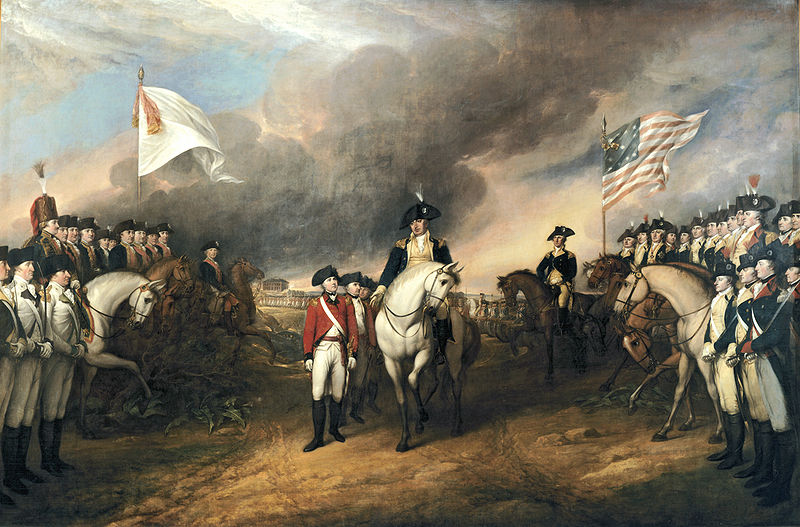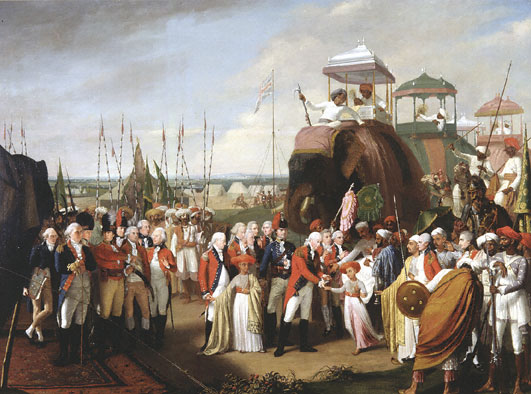<Back to Index>
- Classical Scholar Giovanni Placido Agostino Pascoli, 1855
- Painter Hermann Max Pechstein, 1881
- General of the British Army Charles Cornwallis, 1st Marquess Cornwallis, 1738
PAGE SPONSOR
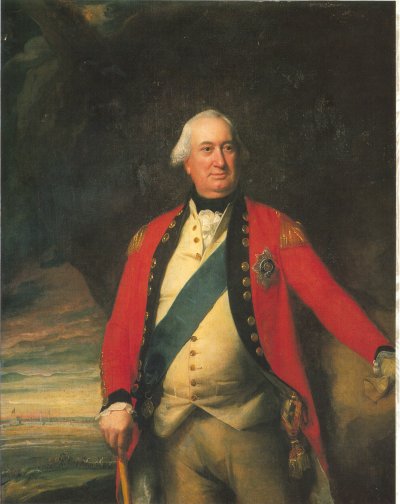
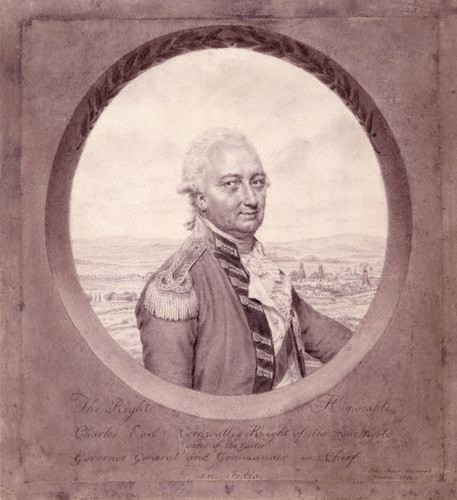
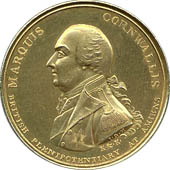
Charles Cornwallis, 1st Marquess Cornwallis KG (31 December 1738 – 5 October 1805), styled Viscount Brome between 1753 and 1762 and known as The Earl Cornwallis between 1762 and 1792, was a British Army officer and colonial administrator. In the United States and the United Kingdom he is best remembered as one of the leading British generals in the American War of Independence. His surrender in 1781 to a combined American and French force at the Siege of Yorktown ended significant hostilities in North America. He also served as a civil and military governor in Ireland and India; in both places he brought about significant changes, including the Act of Union in Ireland and the Cornwallis Code, including the Permanent Settlement, in India.
Born into an aristocratic family and educated at Eton and Cambridge, Cornwallis joined the British Army in 1757, seeing action in the Seven Years' War. Upon his father's death in 1762 he became Earl Cornwallis and entered the House of Lords. Promoted to colonel in 1766, he next saw military action in 1776 in the American War of Independence. Active in the advance forces of many campaigns, in 1776 he notably made possible the Battle of Princeton, an embarrassing British defeat, and surrendered his army at Yorktown in October 1781 after an extended campaign which was marked by disagreements between him and his superior, General Sir Henry Clinton, which became public knowledge after the war.
Despite this defeat, Cornwallis retained the confidence of successive British governments and continued to enjoy an active career. Knighted in 1786, he was in that year appointed to be Governor General and commander - in - chief in India, where he enacted numerous significant reforms within the East India Company and its territories, including the Cornwallis Code, part of which implemented important land taxation reforms known as the Permanent Settlement. From 1789 to 1792 he led British and Company forces in the Third Anglo - Mysore War to defeat the Mysorean ruler Tipu Sultan.
Returning to England in 1794, Cornwallis was given the post of Master - General of the Ordnance. In 1798 he was appointed Lord Lieutenant and Commander - in - chief of Ireland, where he oversaw the response to the 1798 Irish Rebellion, including a French invasion of Ireland, and was instrumental in bringing about the Union of Great Britain and Ireland.
Cornwallis was the chief British signatory to the 1802 Treaty of Amiens, and he was reappointed to India in 1805. He died in India not long after his arrival. Cornwallis was the eldest son of Charles Cornwallis, 5th Baron Cornwallis, later 1st Earl Cornwallis, and was born in Grosvenor Square, London, England, even though his family's estates were in Kent. The Cornwallis family was established at Brome Hall, near Eye,Suffolk, in the 14th century, and its members occasionally represented the county in the House of Commons over the next three hundred years. Frederick Cornwallis, created a Baronet in 1627, fought for King Charles I, and followed King Charles II into exile. He was made Baron Cornwallis, of Eye in the County of Suffolk,
in 1661, and by judicious marriages his descendants increased the
importance of the family. Cornwallis was extremely well connected. His mother, Elizabeth Townshend (died 1 December 1785), was the daughter of the 2nd Viscount Townshend and a niece of the Prime Minister, Sir Robert Walpole. His father was created Earl Cornwallis and Viscount Brome in 1753, at which point the young Charles was styled Viscount Brome. His brother became Admiral Sir William Cornwallis. An uncle, Frederick, was Archbishop of Canterbury, and another uncle, Edward, was a military officer, colonial governor, and founder of Halifax, Nova Scotia.
Cornwallis was educated at Eton College and Clare College, Cambridge. While at Eton, he received an injury to his eye by an accidental blow while playing hockey, from Shute Barrington, later Bishop of Durham. He obtained his first commission as Ensign in the 1st Foot Guards, on 8 December 1757. His military education then commenced, and after travelling on the continent with a Prussian officer, Captain de Roguin, he studied at the military academy of Turin. He also became a Member of Parliament in January 1760, entering the House of Commons for the village of Wye in Kent. He succeeded his father as 2nd Earl Cornwallis in 1762, which resulted in his elevation to the House of Lords. Throughout the Seven Years' War,
Lord Cornwallis served four terms in different posts in Germany,
interspersed with trips home. Upon learning that British troops were
being sent to Germany in 1758, he hurried to join them without waiting
for orders from home and secured an appointment as a staff officer to Lord Granby. A year later, he participated at the Battle of Minden, a major battle that prevented a French invasion of Hanover. After the battle, he purchased a captaincy in the 85th Regiment of Foot. In 1761, he served with the 12th Foot and was promoted to Brevet Lieutenant - Colonel. He led his regiment in the Battle of Villinghausen on 15 – 16 July 1761, and was noted for his gallantry. In 1762 his regiment was involved in heavy fighting during the Battle of Wilhelmsthal. A few weeks later they defeated Saxon troops at the Battle of Lutterberg and ended the year by participating in the Siege of Cassel. Following the 1763 Treaty of Paris he returned to Britain, where he became a political protege of the leading Whig magnate, and future Prime Minister, Lord Rockingham. He became colonel of the 33rd Regiment of Foot in 1766. The same year he voted along with five other peers against the Stamp Act, out of sympathy with the American colonists. He maintained a strong degree of support for the colonists during the tensions and crisis that led to the American War of Independence. In 1768 he married Jemima Tullekin Jones, the daughter of a regimental colonel. They had two children, a boy and a girl, before Jemima died in 1779, and were by all accounts a happy, devoted couple.
With
the outbreak of the war in North America, Cornwallis put his previous
misgivings aside and sought active service. Promoted to lieutenant
general in North America, his service began in 1776 with service under
General Sir
Henry Clinton with the failed Siege of Charleston. He and Clinton sailed for New York City, where they participated in General William Howe's campaign for New York City. Cornwallis was often given a leading role during this campaign; his division was in the lead at the Battle of Long Island, and he chased the retreating George Washington across New Jersey after the city fell. General Howe granted Cornwallis leave in December 1776; however it was cancelled after Washington launched his surprise attack on Trenton on
December 26. Howe ordered Cornwallis to return to New Jersey to deal
with Washington. Cornwallis gathered together garrisons scattered
across New Jersey and moved them towards Trenton. On 2 January 1777, as
he advanced on Trenton, his forces were engaged in extended skirmishing
that delayed the army's arrival at Washington's position on the Assunpink Creek until late in the day. Cornwallis was unable to dislodge Washington in the battle that followed.
Cornwallis prepared his troops to continue the assault of Washington's
position the next day, and critically failed to send out adequate
patrols to monitor the Americans. During the night, Washington's forces
slipped around Cornwallis's and attacked the British outpost at Princeton.
Washington's success was aided by a deception: he had men maintain
blazing campfires and keep up sounds of camp activity during his
movement. Cornwallis spent the winter in New York and New Jersey. Cornwallis continued to serve under Howe on his campaign for control of the rebel capital, Philadelphia. Cornwallis was again often in an advance role, leading the flanking manoeuvre at the Battle of Brandywine, and playing key roles at Germantown and Fort Mercer. With the army in winter quarters in Philadelphia, Cornwallis finally
returned home for leave. Upon his return in 1778, Howe had been
replaced by Clinton as commander in chief, and Cornwallis was now
second in command. The entry of France into the war prompted
the British leaders to redeploy their armed forces for a more global
war, and Philadelphia was abandoned. Cornwallis commanded the rearguard
during the overland withdrawal to New York City and played an important
role in the Battle of Monmouth on
28 June 1778. After a surprise attack on the British rearguard,
Cornwallis launched a counter - attack which checked the enemy advance.
In November 1778, Cornwallis once more returned to England to be with
his ailing wife Jemima, who died in February 1779.
Cornwallis
returned to America in July, 1779, where he was to play a central role
as the lead commander of the British "Southern strategy". At the end of
1779, Henry Clinton and Cornwallis transported a large force south and
initiated the
second siege of Charleston during the spring of 1780, which resulted in the surrender of the Continental forces under Benjamin Lincoln. After the siege of Charleston and the destruction of Abraham Buford's Virginia regiments at Waxhaw,
Clinton returned to New York, leaving Cornwallis in command in the
south. The relationship between Clinton and Cornwallis had noticeably
soured during the Charleston campaign, and they were barely on speaking
terms when Clinton left. Cornwallis
was faced with the task of seeking an outright victory over the enemy,
something General Howe had failed to do in the north in spite of
winning several battles. The
forces he was given to accomplish this were limited by the necessity of
keeping a large British force in New York under Clinton to shadow
Washington. Cornwallis was told by his superiors to utilise the support
of Loyalists, who were believed to be more numerous in the southern colonies.
Personally, Cornwallis favoured a bolder and more aggressive approach
than either Clinton or Howe had. He
also expanded on an existing British policy of recruiting black slaves,
who overwhelmingly favoured the Loyalist cause, as scouts, laborers and
soldiers. In August 1780 Cornwallis' forces met a larger but relatively untried army under the command of Horatio Gates at the Battle of Camden, where they inflicted heavy casualties and routed part of the force. This
served to effectively clear South Carolina of Continental forces, and
was a blow to rebel morale. The victory added to his reputation, though
the rout of the American rebels was owed as much to the failings of
Gates as to the skill of Cornwallis. As the opposition seemed to melt
away, Cornwallis began to advance north into North Carolina while
militia activity continued to harass the troops he left in South
Carolina. Attempts by Cornwallis to rally Loyalist support were dealt
significant blows when a large gathering of them was defeated at Kings Mountain, only a day's march from Cornwallis and his army, and another large detachment of his army was decisively defeated at Cowpens. He then clashed with the rebuilt Continental army under General Nathanael Greene at Guilford Courthouse in
North Carolina, winning a Pyrrhic victory with a bayonet charge against
a numerically superior enemy. In the battle, he controversially ordered grape shot to be fired into a mass of combat that resulted in friendly casualties but helped break the American line. Cornwallis then moved his forces to Wilmington on
the coast to resupply. Cornwallis himself had generally been successful
in his battles, but the constant marching and the losses incurred had
shrunk and tired out his army. Greene, whose army was still intact
after the loss at Guilford Courthouse, shadowed Cornwallis toward
Wilmington, but then crossed into South Carolina, where over the course
of several months regained control over most of the state. Cornwallis received dispatches in Wilmington informing him that another British army under Generals William Phillips and Benedict Arnold had been sent to Virginia.
Believing that North Carolina could not be subdued unless its supply
lines from Virginia were cut, he decided to join forces with Phillips.
On
arrival in Virginia, Cornwallis took command of Phillips' army.
Phillips, a personal friend of Cornwallis, died one week before
Cornwallis reached his position at Petersburg.
Having marched without informing Clinton of his movements
(communications between the two British commanders was by sea and
extremely slow, sometimes up to three weeks), he sent word of his northward march and engaged in destroying American supplies in the Chesapeake region.
In March 1781, in response to the threat posed by Arnold and Phillips, General Washington had dispatched Marquis de Lafayette to defend Virginia. The young Frenchman had 3,200 men at his command, but British troops in the state now totalled 7,200. Lafayette skirmished with Cornwallis, avoiding a decisive battle while gathering
reinforcements. It was during this period that Cornwallis received
orders from Clinton to choose a position on theVirginia Peninsula — referred to in contemporary letters as the "Williamsburg Neck" — and construct a fortified naval post to shelter ships of the line. In
complying with this order, Cornwallis put himself in a position to
become trapped. With the arrival of the French fleet under the Comte de Grasse and General George Washington's combined French - American army, Cornwallis found himself cut off. After the Royal Navy fleet under Admiral Thomas Graves was defeated by the French at the Battle of the Chesapeake, and the French siege train arrived from Newport, Rhode Island, his position became untenable. He surrendered to General Washington and the French commander, the Comte de Rochambeau, on 19 October 1781. Cornwallis, apparently not wanting to face Washington, claimed to be ill on the day of the surrender, and sent Brigadier General Charles O'Hara in
his place to formally surrender his sword. Washington had his second -
in - command, Benjamin Lincoln, accept Cornwallis' sword. In 1782 Cornwallis was exchanged for Henry Laurens, who had been held in London and was considered a prisoner of equal rank. He returned to Britain with Benedict Arnold, and they were cheered when they landed in England on 21 January 1782. His
surrender did not mark the end of the war, though it ended major
fighting in the American theatre. Because he was released on parole,
Cornwallis refused to serve until the war came to an end in 1783. His
tactics in America, especially during the southern campaign, were a
frequent subject of criticism by his political enemies in London,
including General Clinton, who tried to blame him for the failures of
the southern campaign. Cornwallis, however, retained the confidence of King George III and the British government of William Pitt the Younger. In August 1785 he attended manoeuvres in Prussia along with the Duke of York where they encountered Frederick the Great and de Lafayette.
In 1786 Cornwallis was made a
Knight Companion of The Most Noble Order of the Garter. The same year he was appointed Governor - General and commander in chief in India. Cornwallis
engaged in reforms of all types, that had an impact on many areas of
civil, military, and corporate administration. According to historian
Jerry Dupont, Cornwallis was responsible for "laying the foundation for
British rule throughout India and setting standards for the services,
courts, and revenue collection that remained remarkably unaltered
almost to the end of the British era." He also enacted important reforms in the operations of the British East India Company, and, with the notable exception of the Kingdom of Mysore, managed to keep the company out of military conflicts during his tenure. Prior
to Cornwallis's tenure, company employees were allowed to trade on
their own accounts and use company ships to send their own goods back
to Europe. This practice was tolerated when the company was profitable,
but by the 1780s the company's finances were not in good shape.
Cornwallis eliminated the practice, increasing employee salaries in
compensation. He also worked to reduce nepotism and political
favoritism, instituting the practice of merit - based advancement. Criminal
and civil justice systems in the company's territories were a confusing
overlay of legal systems, jurisdictions, and methods of administration.
Cornwallis had the company take over the few remaining judicial powers
of the Nawab of Bengal, the titular local ruler of much of the Bengal Presidency, and gave some judicial powers to company employees. In 1790 he introduced circuit courts with company employees as judges, and set up a court of appeals in Calcutta. He had the legal frameworks of Muslim and Hindu law
translated into English, and promulgated administrative regulations and
a new civil and criminal code. This work, introduced in 1793, was known
as the Cornwallis Code.
One consequence of the code was that it instituted a type of racism,
placing the British as an elite class on top of the complex status
hierarchy of caste and religion that existed in India at the time. Cornwallis held racist views, in a manner common at the time; of mixed
European - Indians he wrote, "...as on account of their colour &
extraction they are considered in this country as inferior to
Europeans, I am of opinion that those of them who possess the best
abilities could not command that authority and respect which is
necessary in the due discharge of the duty of an officer." Cornwallis's
attitude toward the lower classes did, however, include a benevolent
and somewhat paternalistic desire to improve their condition. He
introduced legislation to protect native weavers who were sometimes
forced into working at starvation wages by unscrupulous company
employees, outlawed child slavery, and established in 1791 a Sanskrit
college for Hindus that is now the Government Sanskrit College in Benares. He also established a mint in Calcutta that, in addition to benefiting the poor by providing a reliable standard currency, was a forerunner of India's modern currency. Part of the Cornwallis Code was an important land taxation reform known in India as the Permanent Settlement. This reform permanently altered the way the company collected taxes in its territories, by taxing landowners (known as zamindars)
based on the value of their land and not necessarily the value of its
produce. The reforms were also designed to protect land tenants (ryots) from abusive practices of the zamindars intended to maximize production. Cornwallis
had been sent to India with instructions to avoid conflict with the
company's neighbors. Early in his tenure he abrogated agreements with
the Maratha Empire and the Nizam of Hyderabad that he saw as violating the 1784 Treaty of Mangalore that ended the Second Anglo - Mysore War. This ensured the company's non-involvement in the Maratha - Mysore War (1785 – 1787). He was, however, manouevred into the establishment of a new company based at Penang (in present - day Malaysia), where conflict was avoided when he agreed to pay a stipend to the local rajah for use of the base. Fort Cornwallis in Penang is named for Cornwallis. The King of Nepal appealed
to Cornwallis in 1792 for military assistance. Cornwallis declined the
king's request, sending instead Colonel William Kirkpatrick to mediate
the dispute. Kirkpatrick was the first Englishman to see Nepal; by the
time he reached Kathmandu in 1793, the parties had already resolved their dispute. The company was unavoidably drawn into war with Mysore in 1790. Tipu Sultan,
Mysore's ruler, had expressed contempt for the British not long after
signing the 1784 Treaty of Mangalore, and also expressed a desire to
renew conflict with them. In late 1789 he invaded the Kingdom of Travancore,
a company ally according to that treaty, because of territorial
disputes and Travancore's harbouring of refugees from other Mysorean
actions. Cornwallis ordered company and Crown troops to mobilize in response. The 1790 campaign against Tipu was conducted by General William Medows, and it was a limited success. Medows successfully occupied the Coimbatore district,
but Tipu counterattacked and was able to reduce the British position to
a small number of strongly held outposts. Tipu then invaded the Carnatic,
where he attempted unsuccessfully to draw the French into the conflict.
Because of Medows' weak campaigning, Cornwallis personally took command
of the British forces in 1791. When the war broke out, Cornwallis negotiated alliances with the Marathas and Hyderabad. Cornwallis ascended the Eastern Ghats to reach the Deccan Plateau in February 1791. After successfully besieging Bangalore,
Cornwallis then joined forces with Hyderabadi forces that he described
as "extremely defective in almost every point of military discipline",
and their presence in the army ultimately presented more difficulties
than assistance. These forces then marched toward the Mysorean capital at Seringapatam, and forced Tipu to retreat into the city at the Battle of Arakere on
15 May. Dwindling provisions, exacerbated by Tipu's slash - and - burn
tactics, forced Cornwallis to abandon the idea of besieging
Seringapatam that season, so he retreated to Bangalore. In
January 1792 the army, now well provisioned, set out for Seringapatam.
Arriving before the city on 5 February, Cornwallis quickly eliminated Tipu's defensive positions outside the city, and then began siege operations. Tipu requested negotiations on 23 February, and peace was agreed in
18 March. Cornwallis and his allies demanded the cession of half of
Mysorean territory, much of which went to the allies. As a guarantee of
Tipu's performance, two of his sons were delivered to Cornwallis as
hostages. Cornwallis and other British commanders, in a move
appreciated by their soldiers, donated prize money awarded them to be
distributed among the rank and file. For his success in conducting the war, Cornwallis was created Marquess Cornwallis in 1792. He returned to England the following year, and was succeeded by Sir John Shore. Cornwallis was made Lord Lieutenant of Ireland and Commander - in - Chief, Ireland, in June 1798, after the outbreak of the Irish Rebellion of 1798 between republican United Irishmen and the government. His appointment was greeted unfavourably by the Irish elite, who preferred his predecessor Lord Camden,
and suspected he had liberal sympathies with the predominantly Catholic
rebels. However, he struck up a good working relationship with Lord Castelreagh, the Chief Secretary for Ireland. In
his combined role as both Viceroy and Commander - in - Chief Cornwallis
oversaw the defeat of both the Irish rebels and a French invasion force
led by General Humbert that landed in Connacht in August 1798. Panicked by the landing, and the British defeat at the Battle of Castlebar, thousands of reinforcements were despatched to Ireland swelling his forces to 60,000. The French invaders were defeated and forced to surrender at the Battle of Ballinamuck.
During the autumn Cornwallis secured government control over the
island, and organised the suppression of the remaining supporters of
the United Irish movement. He was also responsible for ordering the Military Road in Wicklow built, to root out rebels to the south of Dublin.
It was part of a lengthy operation in mopping up the last areas of
resistance, which lasted until Cornwallis' departure in 1801. Cornwallis was also instrumental in securing passage in 1800 of the Act of Union by the Parliament of Ireland, which resulted in the creation of the United Kingdom of Great Britain and Ireland. The process, which essentially required the buying of votes in the Parliament of Ireland through
patronage and the granting of peerages, was one that Cornwallis found
quite distasteful: he wrote "It has been the wish of my life to avoid
all this dirty business, and now I am involved in it beyond bearing".
Although Cornwallis recognised that the union with Ireland was unlikely
to succeed without Catholic emancipation,
he and William Pitt were unable to move King George on the subject,
with the result that Pitt's government fell, and Cornwallis resigned
his offices, returning to London in May 1801.
Cornwallis negotiated the terms of the Treaty of Amiens, which he signed on behalf the United Kingdom on 25 March 1802 with Napoleon. He and General Charles O'Hara (his
second in command from Charleston to Yorktown) have the rare
distinction of dealing with both Washington and Napoleon. The treaty
ended the War of the Second Coalition, made possible by financial pressure and the resignation of William Pitt on 16 February 1801. Henry Addington succeeded
Pitt, and appointed Cornwallis Minister Plenipotentiary. The British
negotiators in Paris were led by Robert Jenkinson, Lord Liverpool. Despite their efforts, the peace soon broke down, and war recommenced.
He was reappointed Governor - General of India in 1805, but on 5 October, shortly after arriving, died of a fever at Gauspur in Ghazipur, at that time in the Varanasi kingdom. Cornwallis was buried there, overlooking the Ganges River, where his memorial continues to be maintained by the Government of India. Today Cornwallis is remembered primarily in the United States as the British commander
who surrendered at Yorktown. Because of the enormous impact the
siege — and its result — had on American history he is still fairly well
known in the United States, and is often referenced in popular culture. In the 1835 novel Horse - Shoe Robinson by John Pendleton Kennedy,
a historical romance set against the background of the Southern
campaigns in the American War of Independence, Cornwallis appears and
interacts with the fictional characters in the book. He is depicted as
courtly in manner, but tolerant or even supportive of brutal practices
against those found deficient among his own forces and against enemy
prisoners. In the 2000 film The Patriot about the events leading up to Yorktown, Cornwallis was portrayed by English actor Tom Wilkinson. In Ireland he achieved a notoriety that lasts to this day because of the execution of rebel prisoners in Ballinalee after the Battle of Ballinamuck. In the village, in the north Leinster county of Longford, the site of the executions is known as Bully's Acre. In India he is remembered for his victory against Tipu Sultan in Nandi Hills in
the Mysore war and promulgation of revenue and judicial acts.
Cornwallis is also known in India for his brutality and cunning. Fort Cornwallis, founded in 1786 in George Town, Prince of Wales Island (now the island part of the Malaysian state of Penang), is named after General Cornwallis. He also has a building named after him at the University of Kent, Canterbury, and boarding houses at The Royal Hospital School and Culford School in Suffolk. A large statue of Cornwallis can be seen in St. Paul's Cathedral, London.
